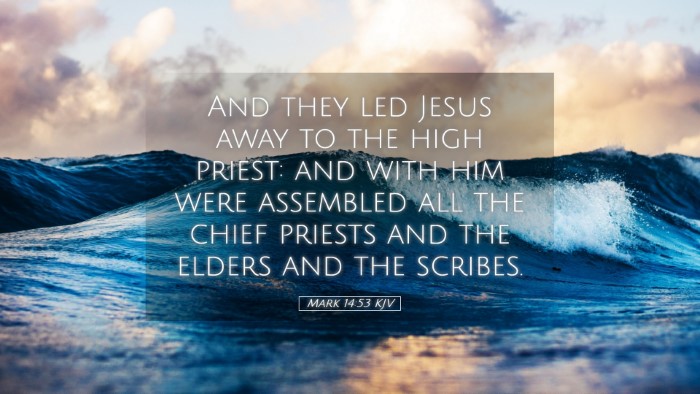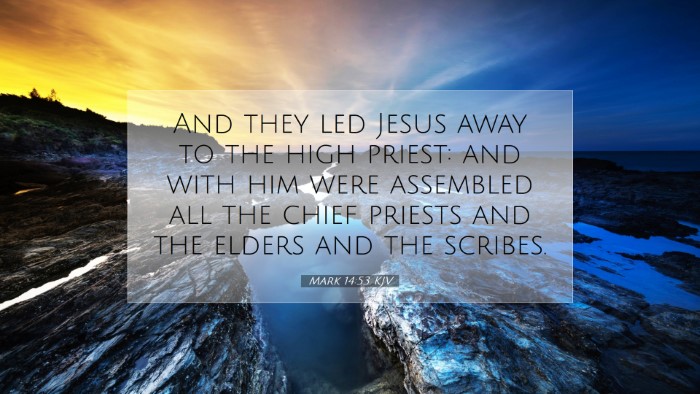Commentary on Mark 14:53
Mark 14:53 states: "And they led Jesus away to the high priest: and with him were assembled all the chief priests and the elders and the scribes."
This verse marks a pivotal point in the narrative of the Passion of Christ, setting the stage for His trial and crucifixion. The following commentary draws from various public domain sources to explore its theological implications, historical context, and relevance to contemporary readers, particularly for pastors, students, theologians, and Bible scholars.
Contextual Overview
The arrest of Jesus leads us directly into the heart of the Passion narrative. Following the Last Supper and Gethsemane, Jesus is taken into custody, and His first trial begins. This verse sets the scene for this momentous event, highlighting the gravity of what is to transpire.
The High Priest
The reference to the "high priest" is significant in understanding the legal and religious framework of the time. According to Matthew Henry, the high priest serves as the primary religious authority, wielding considerable influence over the Sanhedrin, the Jewish ruling council. In this instance, Jesus is brought before Caiaphas, who exemplifies the corrupt and politically motivated leadership of the Jewish religious elite.
Albert Barnes further explores the implications of this setting, noting that the chief priests and elders gathered reflect the coalition of religious and temporal power that existed in Jerusalem. Their collaboration underscores the systemic nature of the opposition Jesus faced — a united front of religious leaders conspiring against Him.
Assembly of Leaders
Mark notes the assembly of "all the chief priests and the elders and the scribes," indicating not only a formal trial but a collective effort to condemn Jesus. Adam Clarke remarks on the diversity of this group, including various sects such as the Sadducees and Pharisees, who typically had differing beliefs but were united in their desire to eliminate the threat posed by Jesus' ministry.
This convergence of power figures is crucial as it highlights the extent of Jesus' opposition. Their presence also implies a level of premeditated intent. They were not simply reacting to a situation but actively orchestrating a series of events to secure Jesus' death.
Theological Implications
The transition from the peaceful moments of the Last Supper to the tension-laden arrest reveals profound theological implications. This act can be seen as the fulfillment of prophetic scriptures that pointed toward betrayal and suffering. According to Matthew Henry, this is part of God’s sovereign plan, orchestrating events that lead through suffering to redemption.
Fulfillment of Prophecies
This moment aligns with various Old Testament prophecies. For instance, Isaiah's suffering servant (Isaiah 53) foresees the unjust trials and afflictions that Jesus would endure. Albert Barnes emphasizes that understanding these connections deepens our comprehension of Jesus' mission and the necessity of His sacrificial death.
Jesus as the Innocent Sufferer
In focusing on Jesus being led away to trial, scholars often draw attention to the stark contrast of His innocence against the backdrop of wrongful accusation. Adam Clarke poignantly notes that Jesus, though unjustly condemned, continues to fulfill His role as Redeemer, providing a model of humility and submission under unjust circumstances.
Practical Applications
For modern readers, particularly leaders in the church, this passage offers rich lessons on the nature of power dynamics and the struggles associated with leadership. As they navigate complex situations and opposition, pastors can draw on Jesus' example of composure and purpose. Here are some practical applications:
- Integrity in Leadership: Reflect on the motives and integrity of one’s own leadership; are they emulating Christ's humility or Caiaphas' ambition?
- Response to Opposition: Consider how one reacts when faced with betrayal or unjust treatment. Jesus’ demeanor serves as a case study in grace under pressure.
- Commitment to Truth: Jesus' unwavering commitment to truth amidst accusations serves as a reminder for leaders to remain anchored in biblical truths even when facing opposition.
Conclusion
Mark 14:53 initiates a critical juncture in the Gospel narrative, encapsulating themes of betrayal, injustice, and the sovereignty of God. Through the insights of public domain commentators, we recognize the theological depths and practical applications inherent in this passage. As believers and leaders seek to navigate the complexities of faith and adversity, Jesus' experience here remains a cornerstone for understanding the cost of discipleship and the ultimate triumph of God's redemptive plan.


